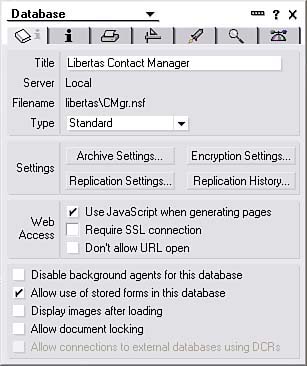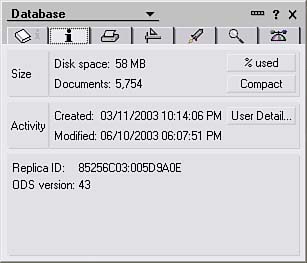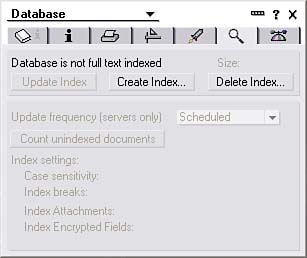Setting Database Properties
Many of the settings used during the creation of Domino databases can be modified after the database has been created. Many other options are not available for modification until after the database has been created. Nevertheless, these settings control the database's capabilities for Notes clients and Web clients.
The Database properties box has seven tabs on which you can specify the settings and attributes of the currently selected database. Some of these settings are global to all the documents contained within the database. Other properties control how the Domino server reacts to Web clients versus Notes clients. Some of the newer features contained on the Advanced tab can be modified to improve the database performance and take advantage of the database ODS.
All the database options are available from the Database properties box. To modify the database properties, right-click the database bookmark title and select Database, Properties from the drop-down menu to open the Database properties box shown in Figure 2.8. If the database is currently open, you can also click on the Properties Box icon from either the SmartIcon bar or click the Properties Box button located by the Preview buttons in the top-right corner of the window.
Figure 2.8. The Database properties box.

In “Creating a Blank Database,” earlier in this chapter, you learned about the Advanced Tab of the Database properties box and its settings. Please refer to Figure 2.4 and Table 2.1 to review that information. The options on each of the remaining Database properties box tabs are described in the following sections.
Database Basics Tab
The Database Basics tab is the first tab available from the Database properties box. This tab displays the settings listed in Table 2.3.
| Setting | Setting Type | Description |
|---|---|---|
| Title | Editable text | The database title. |
| Server | Display only | The server where the current database is located. |
| Filename | Display only | The file path and filename of the current database. |
| Database Type | Drop-down selection | Determines the type of design elements the database is to contain and the default functionality. |
| Archive Settings | Button | Opens the Archive Settings dialog box. |
| Encryption Settings | Button | Click the Encryption button to choose encryption settings. Click the Replication button to choose Replication settings. |
| Replication Settings | Button | Opens the Replication Settings dialog box. |
| Replication History | Button | Opens the Replication History dialog box. |
| Web Access: Use JavaScript When Generating Pages | Check box | Enables the use of additional @commands and multiple buttons on forms and converts many @commands to JavaScript. |
| Web Access: Require SSL Connection | Check box | Forces Web clients to log in using SSL (Secure Sockets Layer). |
| Web Access: Don't Allow URL open | Check box | Restricts Web users from using URL commands to open the database, forms, views, and so on. |
| Disable Background Agents for This Database | Check box | Determines whether background can be run on the database. |
| Allow Use of Stored Forms in This Database | Check box | Determines whether the setting to store form design elements in documents can be enabled. |
| Display Images After Loading | Check box | This setting controls whether images should be displayed after the entire document has been loaded. |
| Allow Document Locking | Check box | Allows users with Author access or higher to lock documents. |
| Allow Connections to External Databases Using DCRs | Check box | Allows forms using a data connection resource (DCR) to exchange data with an external database. |
Info Tab
The Info tab contains general information about the Domino database (see Figure 2.9).
Figure 2.9. The Info tab of the Database properties box.

The information contained in the Info tab includes the disk space and document count. Click the % Used button to display the percentage of non-whitespace being used by the database. You can click the Compact button to run the Compact task on the database. The Info tab Activity display shows the date and time the database was created and last modified. User Detail indicates the User Activity, if the activity is being recorded. This tab also shows the Replica ID and the ODS version of the active database (this value is different for previous versions of Domino).
Printing Tab
The Printing tab (see Figure 2.10) contains information regarding settings and formatting for printed documents.
The settings on the Printing tab enable you to determine how the database documents will be printed. You can specify whether the current settings refer to the headers or footers. You can type editable text in the Header/Footer Text box, and that text will appear in the document headers and/or footers. List box settings for font, size, and style determine the text Format. Finally, you can choose whether headers and footers will appear on the first page of the document.
Design Tab
The Design tab contains design settings options for the current database.
If the database design is not hidden, the information contained in the Design tab is as described in Table 2.4. If the database design is hidden, no information is displayed on this tab, although the tab still exists. Design locking is described in more detail in “?,” later in this chapter.
| Setting | Setting Type | Description |
|---|---|---|
| Allow Design Locking | Check box | Enables developers to document locking capabilities. |
| List in Database Catalog | Check box | Determines whether database should be listed in database catalog. |
| Categories | Editable text box | If database is set to list in database catalog, determines category for database catalog. |
| Show in 'Open Database' Dialog | Check box | Determines whether this database should appear in the list of databases that appears when users are opening databases. |
| Include in MultiDatabase Indexing | Check box | Determines whether the database should be included in the multidatabase search site queries. |
| Do Not Mark Modified Documents as Unread | Check box | Determines whether modified documents should be marked as unread documents. |
| Inherit Design from Master Template | Check box | Determines whether the database should inherit its design. |
| Template Name | Editable text | If the Inherit Design from Template check box is selected, the name of the template database is specified. |
| Refresh Design on Admin Server Only | Check box | If the Inherit Design from Template check box is selected and template name is specified, indicates whether the inheritance should occur on the admin server only. |
| Database File is a Master Template | Check box | Determines whether the database is a template for other databases. |
| Template Name | Editable text | If the Database is a master template, this field is used to specify the name assigned to this template. |
| List as Advanced Template in 'New Database' Dialog | Check box | If selected, the database appears in the template list only when the new database is created as an advanced database template. |
| Copy Profile Documents with Design | Check box | If selected, profile documents are copied along with design elements. |
| Single Copy Template | Check box | Indicates whether database is single copy template (a new feature in R6 that allows multiple databases to replace design elements with pointers or reference nodes to design elements in the single copy template). |
| Multilingual Database | Check box | Determines whether the database should support multiple international languages, time zones, and regions. If set, developers can build design elements and associate them with a particular language. |
| Default Language | Drop-down | For multilingual databases, allows developer to set default language. |
| Default Region | Drop-down | For multilingual databases, allows developer to set default region if default language has various regional dialects (such as in Spanish). |
| Default Sort Order | Drop-down | For multilingual databases, allows developer to set default sort order for multiple languages. |
| Unicode Standard Sorting | Check box | For multilingual databases with default sort order specified, allows developer to select/deselect Unicode sorting. |
Launch Tab
The Launch tab contains information regarding launch settings for native Lotus Notes clients and Web clients.
The information contained in the Launch tab is described in Table 2.5.
| Setting | Setting Type | Description |
|---|---|---|
| When Opened in the Notes Client | Drop-down | Determines the default design element to open when the database is opened by a native Lotus Notes client. The default launch options for Notes clients are:
|
| Name | Drop-down | The list of specific options based upon the option selected for When Opened in the Notes Client. |
| Restore as Last Viewed by User | Check box | Opens last design element viewed by each respective user. |
| Show “About Database” Document If Modified | Check box | Determines whether the About document should be displayed to Notes clients if its design has been modified since the user last accessed the database. |
| Show “About Database” Document When Database Is Opened for the First Time | Check box | Determines whether the About document should be displayed to Notes client when database is opened for first time. |
| Preview Pane Default… | Button | Determines the default Preview pane layout. This option is not available if the When Opened in the Notes Client option is set to open a Frameset. |
| When Opened in a Browser Drop-down | Determines the default design element to open when the database is opened by a Web client. The default launch options for Web clients are
|
Full Text Tab
Full text indexes enable you to speed up the searching of Notes documents by creating a index of the database (which is stored in another physical database file).
You must have Designer access or higher to create a full-text index of a database.
 | If a user does not have access to create, update, or delete the full-text index, these options are greyed out to the user. |
The Full Text tab contains information regarding Full Text Indexing options (see Figure 2.10).
Click the Update Index button at the top of this tab to update a previously defined index. Click Create Index to open the Create Full Text Index dialog box. The Delete Index button deletes an existing index. Use the Update Frequency drop-down to specify whether updates should occur on a daily, hourly, or other scheduled basis. In the Index Settings area, you can see all the full text index settings, including Case Sensitivity, Index Breaks, Index Attachments, and Index Encrypted Fields.

